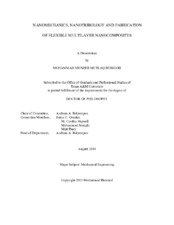| dc.description.abstract | Polymer-based multilayer nanocomposites have become favorable material choice for
many applications such as gas barriers, water membranes, optoelectronic devices, biosensors,
corrosion inhibitors and energy devices. They are finding their ways as a replacement of traditional
metal, silicon oxides and hard inorganic coatings. The present work is dedicated to addressing the
fabrication of new polymer flexible nanocomposites and their mechanical response against normal
and lateral deformation modes, known as nanoindentation and nanoscratch. Particularly, the
scratch resistance of these nanocomposites is critical for many applications.
Little is known in the literature about their nanomechanics, hence reliability and durability
for long-term applications. Better understanding of the nanomechanics and nanotribology of 2D
multilayered thin films and 3D multilayered structures was achieved in this thesis through a series
of different experiments using low and high load nanoindentation, nanoscratch and flat-punch
compression. Complementary computational modeling supported the experimental findings and
further explains their nano- and micromechanical behaviors.
Based on the findings of these nanomechanical experiments, functional multilayered
polymeric coatings consisting of different arrangements of polymers, graphene oxide and clay
were found to be potential material choices for a range of different applications such as low-friction
tribological coatings, vapor/gas barriers and self-healing coatings. Furthermore, 3D
silicon/polymer structures specifically under extreme deformation were found to be a potential
candidate for wearable electronics and flexible microelectromechanical systems (MEMS) sensors
due to the resilient and elastic behavior driven by the geometry-dependent deformation of these
structures.
The last part discusses the development of a new material pertaining to the development of
nanocomposites. On the quest of continuous search of 2D materials, which can act as
reinforcements, a new material, Aluminum diboride (AlBv2) flakes, was introduced and discussed.
High aspect ratio AlBv2 flakes is a potential reinforcement for conductive polymer nanocomposites
due to the metallic conductivity in the axis parallel to the basal hexagonal plane.
In summary, the findings above focused on the mechanics and tribology of nanocomposites
at the nanoscale mainly for gas barrier applications and MEMS devices. However, the knowledge
can also be extended to other devices such as energy harvesting devices and membranes where
tribology issues at the nanoscale are of important concerns. | en |


